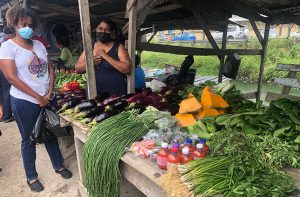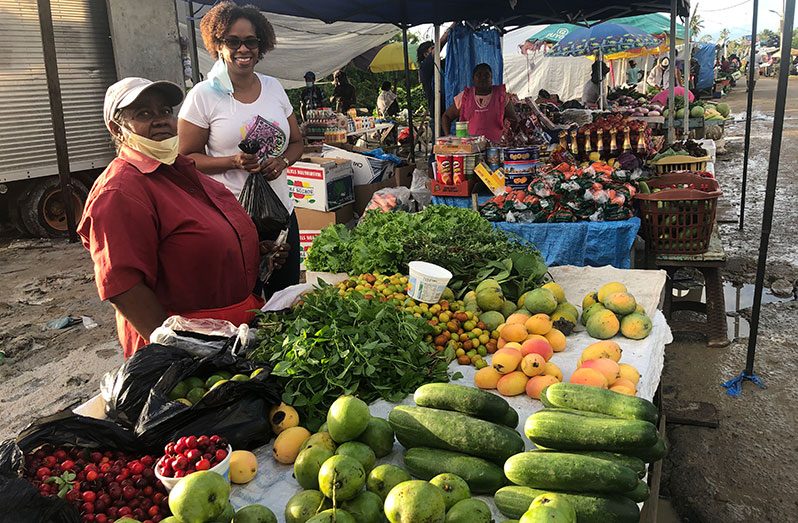WHETHER it is Anna Regina, Georgetown or Corriverton, Guyana’s markets appear traditionally dominated by women vendors. Be it fresh fruits and vegetables or agro-processed products, their stalls often display agro-food in abundance and variety, as their melodious chants soar above usual market hustle and bustle: “Sweet girl, what you shopping today? A have nice fine bora” or “What you getting today, love?”
In the heart of this lively, vibrant yet complex market surface, and deeper into the country’s agri-food chain, women play many roles – as producers, processors, retailers, and even distributors or exporters. This year, as 2021 observed International Year of Fruits and Vegetables, it is opportune to zero in on women and their contribution to the agri-food system especially involving fruits and vegetables.

On average, women represent 43 per cent of the world’s agricultural labour force and 47 per cent of the global fisheries labour force, according to the United Nations Food and Agriculture Organization (FAO). These hard-working women produce more than half of the world’s food, despite being less than half of the labour force. Additionally, women account for 60 to 80 per cent of food production in developing countries. A crop yield gap of about 20-30 per cent between male and female farmers is largely due to differential access to resources and inputs. In fact, if the world’s women farmers had the same access to resources as men, 150 million people could be lifted out of poverty. Studies have also indicated that on average women work up to 13 hours per week longer than men in agriculture.
Across many rural and farming communities of Guyana, women are well-known producers of cash crops, growing vegetables like bora, pumpkin, ochro, pak choy, tomatoes, sweet and hot peppers among others, as well as fruits such as watermelons and passion fruit etc. While some of these activities are done as ‘kitchen gardens’ to maintain self-sufficiency and support feeding of individual households, other women like Patricia produce food on a larger scale, to supply traders and the markets. Patricia said, “Every weekday morning from 06:30 hrs to 08:00 hrs, evenings from 17:00 hrs, and on weekends and holidays, I am farming to supplement my salary. Sometimes the market price is very low or the yield may not be so good due to bad weather, but I am a single mother and I have to keep going to maintain my family.”
PROCESSING
Aside from growing the fresh produces, many women are actively engaged in processing these very crops to produce items such as pepper sauces, jams and jellies, and seasoning. There are also women distributors, termed locally as ‘middle-men’ – the ones who buy produce from farmers to wholesale to market vendors. In some instances, these traders travel across regions to source the commodities. For example, a trader may travel to Essequibo every week or fortnightly to purchase fruits and vegetables from Pomeroon farmers and transport same to resell at markets in Georgetown. Women also work with agri-processors and supermarkets to wash, cut and package fruits and vegetables daily for distribution and retail.
Another component in which women have important roles is the overseas export market. According to a Central Bank report, fruits and vegetables contributed US$3.3 million in exports to Guyana’s economy from January to June last year.
Highly perishable fruits and vegetables need special attention to maintain quality and safety.
Appropriate treatment and handling across the supply chain, from production to consumption are important to ensure that waste is minimised. Many markets are either permanent or temporary and whether rain or hot sun, and vendors must ensure that their produce are safely transported and securely stored to remain fresh for buyers. A female vendor of Skeldon Market explained, “You have to know when to buy, what to buy and the amount to buy for resale. For instance, around Diwali and Phagwa, vegetables such as calaloo, pumpkin, and bolounger are high in demand, so we buy plenty and it does sell out.”
So, what happens when the perishables are left on hand? According to Nina of Port Mourant, “If the fruits and vegetables can keep, we sell them the next day, if not, we cook them or share with neighbours and regular customers.”
SIGNIFICANT AMOUNT GOES TO WASTE
Unfortunately, a significant amount goes to waste, as evidenced by the piles of garbage that are seen at the end of many a market day. This loss and waste represent investment in resources, often by the farmers, but also to the country. Despite the central role of women in the open markets, limited market infrastructure to support long working hours makes it harder for female stallholders. Other challenges faced are pricing, competition, and transportation cost.
The dedication and commitment of women to the supply chain are indispensable to preserving the value of fruits and vegetables. Guardians of much of our food culture and organisers of the market business, they generate income, support empowerment, create livelihoods, and improve food security and nutrition. The income of many women-led households depends on the fruits and vegetable supply chain and at the end of a normal workday, they still have household responsibilities, which include ensuring that an adequate amount of nutritious foods are prepared for their families.
Overall, the fruits and vegetables supply chain remain a relatively large and stable industry that proposes opportunities to reduce post-harvest waste by supporting women’s group with facilities for processing, increasing access to finances and land ownership for female farmers, and improving infrastructure in public retail outlets for women who are working long hours.
FAO continues to partner with the government, farmers and producers, agri-processors, and private sector entities to help supply chains to increase production, enhance availability, safety, affordability, and equitable access to fruits and vegetables. Maximizing the potential of women to earn from the food system will create economic, social, and environmental sustainability. (Shara Seelall, Communication Consultant, FAO)



.jpg)









